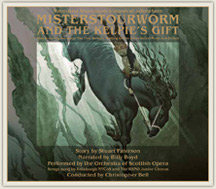Going for gold, silver and bronze New works to mark anniversaries are nothing unusual, but National Youth Choir of Scotland’s artistic director, Christopher Bell, has commissioned an amazing 30 original pieces for its 10th year. Michael Tumelty finds out why
The Herald
Michael Tumelty
IT IS commonplace for a musical organisation wishing to mark a special event or anniversary to commission a new piece for the occasion. It’s a great deal more rare for a group to commission as many as six new works to underline the significance of an occasion, as did the Paragon Ensemble in 1990, marking Glasgow’s year as European City of Culture.
But when an organisation commissions 30 new works from a group of 10 leading composers, then that breaks with all precedent.
That is precisely what the National Youth Choir of Scotland (NYCoS) has done to celebrate its 10th anniversary this year.
Not to be hyperbolic about it, the 30 works are all songs, not symphonies or operas. Nonetheless, it is a momentous happening in Scotland’s musical life, and a stunningly original piece of thinking on the part of Christopher Bell, founder and artistic director of the youth choir, which has become a young artistic powerhouse on the Scottish scene.
The pedigree of the composers who have agreed to take up the challenge speaks for itself, and they range across the spectrum of musical styles.
The list includes Sally Beamish, Edward McGuire, William Sweeney, Martin Dalby, Alasdair Nicolson, Tommy Fowler and Savourna Stevenson. Less familiar names might be Ken Johnston, many of whose arrangements have been sung by NYCoS, Sheena Phillips, who lives in the States, and, representing the younger generation of Scotland’s composers, Oliver Searle.
The concept and execution of the mass commission is even more original than the sheer volume of work put out to the composers. It will sound like a truism, but conventionally, when a new commission is ordered, it is geared towards a performance. Though it will provoke incredulity (it has already), there is not a single performance of the new pieces for NYCoS yet lined up. However, they will all be published in early September in a book that will be widely distributed. What on Earth is it all about?
“Basically, I have been involved in so many commissions in the past which have proved to be oneoff, “says Bell. “They get their first performance, but they don’t get a second.”
He’s busy organising a series of celebratory events to mark the anniversary of the choir, and, quite simply, he says: “I didn’t want to commission one new work for, say, a gala concert, have all the youngsters spend an age learning a tough new piece that was going to get just a single performance and that would be the end of it.”
Additionally, some of the repertoire he is faced with is no longer exactly fresh. “Lots of the Scots songs we currently sing are aeons old. What we want and need is to build a repertoire.”
So he evolved the ingenious commissioning scheme that intends to build the heart of a new repertoire of Scottish choral music for young singers. And it has been very shrewdly thought out.
Not only have the 10 commissioned composers been asked to write three songs each, but they have been instructed to write them to specific criteria. Each must write three songs for particular age ranges, levels of musicianship and technical ability. In other words, each composer’s miniature triptych of songs must be graded.
And within those parameters, Bell has incorporated further criteria. He’s calling the levels bronze, silver and gold.
Each composer, when writing their first level song (bronze) has to write using a simple pentatonic scale: the group of five notes that is the basis of much of the folk songs written across the world and throughout the ages. For their second level song (silver), the composers must expand the range to a full diatonic scale (an octave of white notes, still basic, but with more possibilities). And for the most advanced level (gold), the writing should be chromatic and it can be in unison or two parts, or with a descant.
“Within that, ” Bell told his platoon of experienced composers (with a typically impish smile), “There are no limits to your creativity.”
It sounds a bit technical and convoluted, but the end product will be a book of 30 songs, graded in their difficulty, all fresh, all new, all by well-known composers and all available to every level of youth choir in the country.
With distribution taking place throughout the huge network of choirs operating under the umbrella of NYCoS – there are eight area choirs dotted throughout the country, a training choir, the National Boys Choir, myriad groups in primary school learning-workshop weekly sessions and NYCoS itself, amounting to some 3000 young singers in all, you could be talking, says Bell, “not about just about one performance, but probably several, and possibly dozens, with the prospect of some of the songs becoming common currency”.
The ambitious project lies at the core of a year of high-profile activities for the organisation, including frontline concerts with the BBC SSO in Glasgow and Aberdeen in April, a spring tour of Northern Ireland for the National Boys Choir, a debut appearance at the London Proms with the SSO in the summer, a televised Songs of Praise and a huge 10th anniversary gala concert in the Usher Hall, Edinburgh, in September (which is likely to be with the RSNO).
It is an extraordinary year for the choir, founded in 1996 with just 58 singers and a vision. The full story of NYCoS, with its fascinating origins, its response to and assault upon musical illiteracy, and its rather breathtaking development, is yet to be fully told. But a generation of young people can already testify to its effect..

